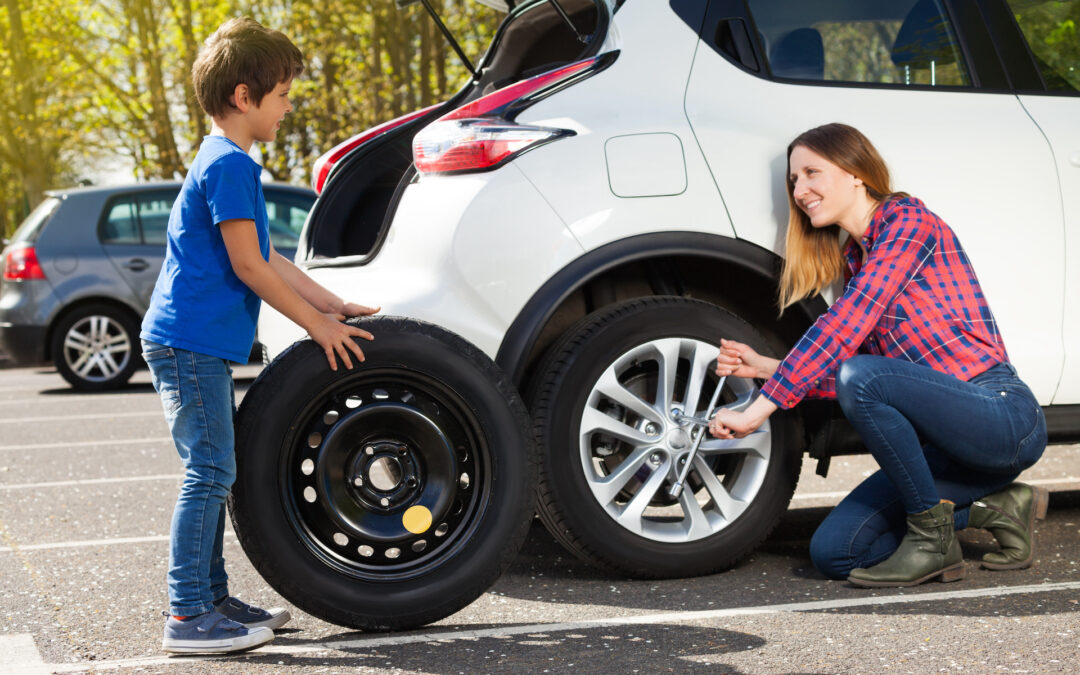Did you ever hear something you just can’t un-hear? And then it keeps rolling through your head over and over…
24 hours before our annual 2,000-mile road trip in July, (hence no article this past month), as I was going over the final checklists (there are 3), a friend asked me: “Did you check your spare tire?”
Guess what? The answer was: NOPE. That item wasn’t on my checklist. But it got me thinking.
Here’s what happened next.
My checking of the spare consisted only of looking to see if I still had one.
All the way to and from our destination, my mind was consumed with what would happen if I needed the spare and if it was even useable.
During our travels, we counted a total of 12 cars on the side of the road, dealing with what was likely the unforeseen and unwelcome experience of changing their tire near speeding cars and with restless passengers.
I felt sure every one of those cars was a sign and just kept waiting for the same to happen to us, worrying about the condition of our spare and what we would do if we needed it.
Fortunately, nothing happened. In my well over one-million miles of driving, I’ve only needed a spare two times. Both ended horribly.
The first time, while on a family vacation, the whole ordeal cost us hours and hours and hundreds of dollars.
The second time was just a few years ago. My phone rang at 5:30 am on a damp cold morning with my (much) better half saying she was stuck on her way to work with a flat. I heroically sprang into action, arrived at the scene, handed her the keys to my car, and said, “I got this—you go on ahead.”
What I didn’t know is that the wheel in question would be seized to the car and even worse, that the spare was flat.
I drove the 5 miles home on the dinky little doughnut rim. Don’t do that. Call for help instead.
Now, let’s get to the point at hand.
Spare tires are like anything else on a car. They have a shelf life. You wouldn’t put 5-year-old tires on your car, would you?
If you have an older car, you may think about not only checking your spare but replacing it. Some auto retailers are starting to present this option to customers and the response has been very well received. Mostly because, well…it just makes sense.
Here’s my ‘spare’ checklist:
1. Locate your spare. Practice getting it in and out of the storage area. In our case, it’s under the center of our car.
2. Check your spare for age and condition. Make sure it’s fully inflated and that it’s not weather checked (ie: cracked). If it’s old, 5-ish years or more, consider getting it replaced at any of our service centers. When traveling over hills and mountains, you don’t want a weak link to consume your thoughts or result in catastrophe.
3. Make sure your spare is the same size as your other tires. Many people change tire sizes and for most vehicles, the diameter has to be the same or it can cause serious damage in short order. If it’s the wrong size, you need to replace it.
4. Get to know your lifting hardware and lift points. Waiting for the wheels to fall off (pun intended) of your vacation or even your daily commute is no time to start reading your owner’s manual. The process to change a tire on some vehicles, specifically minivans and pickup trucks, can be very difficult. Read up on your vehicle’s needs.
5. And finally…PDR (Practice, Drill, Rehearse). In the safety of your driveway, do a couple of practice runs. You may find that some of the hardware is not operating properly. Often the hardware is located underneath and can seize up or perhaps some of it is missing, or bent. Now is the time to find out and get it working properly.
If you have young drivers, please get them involved. They may not like it, but they will appreciate it in the end. That doesn’t mean they will thank you and say you were right. But you’ll feel better knowing they have a fighting chance of helping themselves.
That’s all the “spare time” I have left. Thanks for reading and happy trails to you!
Be safe and keep it movin’…
– Rusty Fender


Recent Comments